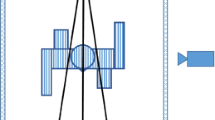Abstract
In this paper, we propose a new view-invariant framework for gait analysis. The framework profits from the dimensionality reduction advantages of Direct Linear Discriminant Analysis (DLDA) to build a unique view-invariant model. Among these advantages is the capability to tackle the under-sampling problem (USP), which commonly occurs when the number of dimensions of the feature space is much larger than the number of training samples. Our framework employs Gait Energy Images (GEIs) as features to create a single joint model suitable for classification of various angles with high accuracy. Performance evaluations shows the advantages of our framework, in terms of computational time and recognition accuracy, as compared to state-of-the-art view-invariant methods.
Access this chapter
Tax calculation will be finalised at checkout
Purchases are for personal use only
Similar content being viewed by others
Notes
- 1.
Our end-to-end implementation is available in: https://yadi.sk/d/MuEE2_tGjJxcq.
References
Bashir, K., Xiang, T., Gong, S.: Gait recognition without subject cooperation. Pattern Recogn. Lett. 31(13), 2052–2060 (2010)
Belhumeur, P.N., Hespanha, J.P., Kriegman, D.J.: Eigenfaces vs. fisherfaces: recognition using class specific linear projection. IEEE Trans. Pattern Anal. Mach. Intell. 19(7), 711–720 (1997)
Bodor, R., Drenner, A., Fehr, D., Masoud, O., Papanikolopoulos, N.: View-independent human motion classification using image-based reconstruction. Image Vision Comput. 27(8), 1194–1206 (2009). http://www.sciencedirect.com/science/article/pii/S0262885608002412
Chapelle, O., Keerthi, S.S.: Efficient algorithms for ranking with SVMs. Inf. Retrieval 13(3), 201–215 (2010)
Chen, L.F., Liao, H.Y.M., Ko, M.T., Lin, J.C., Yu, G.J.: A new lDA-based face recognition system which can solve the small sample size problem. Pattern Recogn. 33(10), 1713–1726 (2000). http://www.sciencedirect.com/science/article/pii/S0031320399001399
Han, J., Bhanu, B.: Individual recognition using gait energy image. IEEE Trans. Pattern Anal. Mach. Intell. 28(2), 316–322 (2006)
Iwama, H., Okumura, M., Makihara, Y., Yagi, Y.: The OU-ISIR gait database comprising the large population dataset and performance evaluation of gait recognition. IEEE Trans. Inf. Forensics Secur. 7(5), 1511–1521 (2012)
Jean, F., Bergevin, R., Albu, A.B.: Computing and evaluating view-normalized body part trajectories. Image Vision Comput. 27(9), 1272–1284 (2009). http://www.sciencedirect.com/science/article/pii/S0262885608002497
Kale, A., Chowdhury, A., Chellappa, R.: Towards a view invariant gait recognition algorithm. In: IEEE Conference on Proceedings of Advanced Video and Signal Based Surveillance, July 2003, pp. 143–150 (2003)
Kusakunniran, W., Wu, Q., Zhang, J., Li, H.: Gait recognition under various viewing angles based on correlated motion regression. IEEE Trans. Circuits Syst. Video Technol. 22(6), 966–980 (2012)
Liu, N., Lu, J., Tan, Y.P.: Joint subspace learning for view-invariant gait recognition. IEEE Signal Process. Lett. 18(7), 431–434 (2011)
Liu, N., Tan, Y.P.: View invariant gait recognition. In: IEEE International Conference on Acoustics Speech and Signal Processing (ICASSP), March 2010, pp. 1410–1413 (2010)
Lu, J., Tan, Y.P.: Uncorrelated discriminant simplex analysis for view-invariant gait signal computing. Pattern Recogn. Lett. 31(5), 382–393 (2010). http://www.sciencedirect.com/science/article/pii/S0167865509003092
Makihara, Y., Sagawa, R., Mukaigawa, Y., Echigo, T., Yagi, Y.: Gait recognition using a view transformation model in the frequency domain. In: Leonardis, A., Bischof, H., Pinz, A. (eds.) ECCV 2006. LNCS, vol. 3953, pp. 151–163. Springer, Heidelberg (2006)
Mansur, A., Makihara, Y., Muramatsu, D., Yagi, Y.: Cross-view gait recognition using view-dependent discriminative analysis. In: 2014 IEEE International Joint Conference on Biometrics (IJCB), September 2014, pp. 1–8 (2014)
Martín-Félez, R., Xiang, T.: Gait recognition by ranking. In: Fitzgibbon, A., Lazebnik, S., Perona, P., Sato, Y., Schmid, C. (eds.) ECCV 2012, Part I. LNCS, vol. 7572, pp. 328–341. Springer, Heidelberg (2012). http://dx.doi.org/10.1007/978-3-642-33718-5_24
Muramatsu, D., Shiraishi, A., Makihara, Y., Uddin, M., Yagi, Y.: Gait-based Person recognition using arbitrary view transformation model. IEEE Trans. Image Process. 24(1), 140–154 (2015)
Muramatsu, D., Shiraishi, A., Makihara, Y., Yagi, Y.: Arbitrary view transformation model for gait person authentication. In: 2012 IEEE Fifth International Conference on Biometrics: Theory, Applications and Systems (BTAS), pp. 85–90. IEEE (2012)
Sharma, A., Kumar, A., Daume III., H., Jacobs, D.W.: Generalized multiview analysis: a discriminative latent space. In: 2012 IEEE Conference on Computer Vision and Pattern Recognition (CVPR), pp. 2160–2167. IEEE (2012)
Sugiyama, M.: Dimensionality reduction of multimodal labeled data by local Fisher discriminant analysis. J. Mach. Learn. Res. 8, 1027–1061 (2007). http://dl.acm.org/citation.cfm?id=1248659.1248694
Tao, D., Li, X., Wu, X., Maybank, S.: General tensor discriminant analysis and gabor features for gait recognition. IEEE Trans. Pattern Anal. Mach. Intell. 29(10), 1700–1715 (2007)
Yan, S., Xu, D., Yang, Q., Zhang, L., Tang, X., Zhang, H.J.: Discriminant analysis with tensor representation. In: IEEE Computer Society Conference on Computer Vision and Pattern Recognition, CVPR 2005, vol. 1, pp. 526–532. IEEE (2005)
Yu, H., Yang, J.: A direct LDA algorithm for high-dimensional data with application to face recognition. Pattern Recogn. 34(10), 2067–2070 (2001). http://www.sciencedirect.com/science/article/pii/S003132030000162X
Yu, S., Tan, D., Tan, T.: A framework for evaluating the effect of view angle, clothing and carrying condition on gait recognition. In: 18th International Conference on Pattern Recognition, ICPR 2006, vol. 4, pp. 441–444 (2006)
Zhang, Z., Troje, N.F.: View-independent person identification from human gait. Neurocomputing 69(13), 250–256 (2005). http://www.sciencedirect.com/science/article/pii/S0925231205001797, Neural Networks in Signal Processing 2003 IEEE International Workshop on Neural Networks for Signal Processing
Zhao, G., Liu, G., Li, H., Pietikainen, M.: 3d gait recognition using multiple cameras. In: 7th International Conference on Automatic Face and Gesture Recognition, FGR, April 2006, pp. 529–534 (2006)
Zheng, W.S., Lai, J., Li, S.Z.: 1D-LDA vs. 2D-LDA: when is vector-based linear discriminant analysis better than matrix-based? Pattern Recogn. 41(7), 2156–2172 (2008). http://www.sciencedirect.com/science/article/pii/S0031320307005274
Acknowledgments
This work has been financed by Consejo Nacional de Ciencia y Tecnologia (CONACyT), Mexico and by Secretaria de Educacion Publica, Mexico.
Author information
Authors and Affiliations
Corresponding author
Editor information
Editors and Affiliations
Rights and permissions
Copyright information
© 2016 Springer International Publishing Switzerland
About this paper
Cite this paper
Portillo, J. et al. (2016). View-Invariant Gait Recognition Using a Joint-DLDA Framework. In: Fujita, H., Ali, M., Selamat, A., Sasaki, J., Kurematsu, M. (eds) Trends in Applied Knowledge-Based Systems and Data Science. IEA/AIE 2016. Lecture Notes in Computer Science(), vol 9799. Springer, Cham. https://doi.org/10.1007/978-3-319-42007-3_34
Download citation
DOI: https://doi.org/10.1007/978-3-319-42007-3_34
Published:
Publisher Name: Springer, Cham
Print ISBN: 978-3-319-42006-6
Online ISBN: 978-3-319-42007-3
eBook Packages: Computer ScienceComputer Science (R0)




